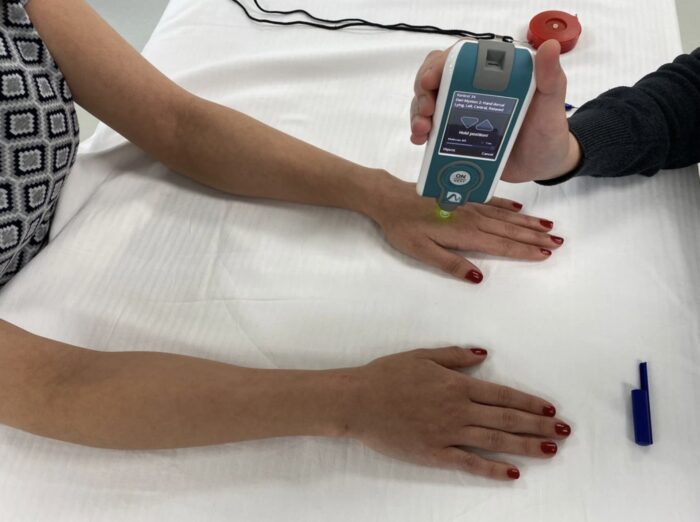Publications

Performance of myotonometer in the assessment of skin involvement in systemic sclerosis
Authors: Ozgul Ozturk 1, Duygu Sahin 2, Ali Omer Acar 1, Tulay Cevik Saldiran 3, Nihan Neval Uzun 2, Nesrin Sen 2, Mehmet Engin Tezcan 2
Affiliations:
- Department of Physiotherapy and Rehabilitation, Acibadem Mehmet Ali Aydinlar University, Kayisdagi St, No:32, Atasehir, Istanbul 34752, Turkey
- Department of Rheumatology, Istanbul Dr. Lutfi Kirdar, Kartal City Hospital, Istanbul, Turkey
- Department of Physiotherapy and Rehabilitation, Bitlis Eren, University, Bitlis, Turkey
Journal: Clinical Rheumatology - December 2023, Volume 43, Pages 695-705 (DOI: 10.1007/s10067-023-06848-6)
-
Field & Applications:
- Medical
- Rheumatology
- Skin / Dermatology
- Reliability
- Validity
- The myotonometer displayed excellent intra- and inter-examiner reproducibility for assessing skin properties.
- Skin tone and stiffness parameters well correlated with the mRSS scores.
- The myotonometer can distinguish patients with diffuse cutaneous SSc from healthy controls.
Objectives: A clinically practical tool to assess skin biomechanical properties rapidly and accurately is still lacking. Our aim was to examine the intra- and inter-observer reproducibility of a myotonometer for objective skin property assessment in systemic sclerosis (SSc), comparing it with the modified Rodnan skin score (mRSS), and distinguishing patients from healthy controls.
Method: Thirty-four patients (21 limited and 13 diffuse SSc), and 31 age and gender-matched healthy controls were enrolled. Skin tone and stiffness were measured at four different anatomical sites (the forearm, hand, leg, and foot) using a myotonometer. The correlation between the mRSS and skin properties was assessed. Also, hand functionality was evaluated for possible correlations between the variables. The differences in skin properties between dcSSc and lcSSc patients, and healthy controls were assessed using variance analysis.
Results: Intra- and inter-examiner reproducibility were excellent (ICC = 0.70 to 0.98) for tone and stiffness except for non-dominant hand tone, which showed good reliability (ICC = 0.64 to 0.74). Stiffness and tone values of the hands, forearms, and feet significantly correlated with mRSS total score (r = 0.40 to 0.71, p < 0.05). Additionally, tone and stiffness of the hands and forearms moderately correlated with hand function (p < 0.05). Tone and stiffness values increased in patients with dcSSc compared to healthy controls, or patients with lcSSc, at the hands, forearms, and legs (p < 0.05).
Conclusions: Our findings emphasize the potential utility of the myotonometer for assessing skin properties and differentiating SSc patients from controls, demonstrating its promise as a valuable clinical evaluation tool in this context.

Figure 1. The assessment of skin properties of the hand.
Keywords: myotonometer, reliability, skin score, systemic sclerosis
In summary, this study indicates that myotonometric measurement of skin tone and stiffness is reliable, exhibiting satisfactory correlations with the gold standard skin assessment method and functionality. Despite its initial development for assessing muscle mechanical properties, the myotonometer device showed promising results in evaluating skin biomechanical characteristics in SSc. The myotonometer can be an alternative quantitative tool for assessing skin involvement in SSc and may aid in determining disease phenotype and staging. Further evaluation of the myotonometer’s utility in detecting skin changes in SSc is warranted.


